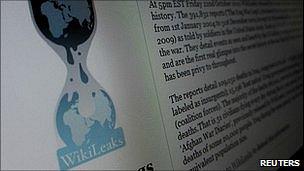Wikileaks website back online after DDoS cyber-attack
- Published

The whistle-blowing website Wikileaks is back online after being disrupted by a distributed denial of service (DDoS) attack for more than a week.
The website said it had been flooded with 10 gigabits per second of traffic, making it slow and unresponsive.
DDoS attacks work by overwhelming websites, clogging network connections and making servers unavailable.
Wikileaks noted that a group calling itself Anti Leaks had said it was behind the attack.
Wikileaks' founder Julian Assange is in Ecuador's London embassy, seeking political asylum.
Mr Assange is trying to avoid extradition to Sweden over rape and assault claims, which he denies.
He faces arrest for breaching the terms of his bail if he leaves the embassy.
Trapwire connection
Wikileaks Press, a Wikileaks-endorsed website that publishes news about the organisation, noted that the attack had started shortly after emails were leaked about surveillance by software company Trapwire.
The firm collects data from CCTV cameras and number plate readers in a bid to forecast acts of terrorism.
The emails were obtained after a hack of US-based intelligence company Stratfor.
Wikileaks started publishing millions of emails from Stratfor in February. Many were related to US government agencies such as the Department of Homeland Security and the Defense Intelligence Agency.
But the site was hit by a DDoS attack after it leaked documents about Trapwire earlier this month.
"Yes, Wikileaks revealed a whole bunch of documents on #Trapwire, no, you can't read them easily, because of the current DDoS attack," Wikileaks tweeted.
"Attacks on #Wikileaks are not only intended to prevent secrets from being revealed, but also to maintain a monopoly on influence," said the website in another tweet.
- Published14 August 2012
- Published5 July 2012
- Published11 July 2012
- Published3 December 2010